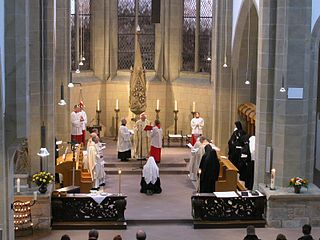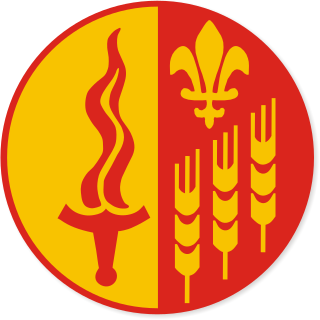
The Congregation of the Legionaries of Christ is a Roman Catholic clerical religious order made up of priests and candidates for the priesthood established by Marcial Maciel in Mexico in 1941. Maciel was also Director General of the congregation for over 60 years until forced to step down in January 2005 as a result of a child sexual abuse scandal.
In the Catholic Church, a religious profession is the solemn admission of men or women into consecrated life by means of the pronouncement of religious vows, typically the evangelical counsels.

Religious vows are the public vows made by the members of religious communities pertaining to their conduct, practices, and views.

The Missionaries of the Precious Blood is a Catholic community of priests and brothers. The society was founded by Saint Gaspar del Bufalo in 1815.
A religious is, in the terminology of many Western Christian denominations, such as the Catholic Church, Lutheran Churches, and Anglican Communion, what in common language one would call a "monk" or "nun". The religious may also include priests if they have undergone ordination, but in general they are not.
The fourth vow is a religious solemn vow that is taken by members of various religious institutes of the Catholic Church, after the three traditional vows of poverty, chastity and obedience. It usually is an expression of the congregation's charism and particular insertion in the apostolic field of the Church.
The Sisters of St. Francis of the Martyr St. George is a Roman Catholic Congregation of consecrated women whose spirituality is derived from St. Francis of Assisi. Mother M. Anselma Bopp and Father John Gerard Dall founded the Order in Thuine, Germany, in 1869. The Order expanded to the U.S. in 1923 with the founding of a Provincialate and Novitiate in Alton, Illinois, which continues to be the location of the Provincial House. They are also located in other areas of Illinois, Missouri, Oklahoma, Nebraska, Kansas, New Jersey, Ohio, Washington, D.C., and Wisconsin, as well as on missions in Brazil and Cuba.

The Society of the Divine Word, abbreviated SVD and popularly called the Verbites or the Divine Word Missionaries, and sometimes the Steyler Missionaries, is a Catholic clerical religious congregation of Pontifical Right for men. As of 2020, it consisted of 5,965 members composed of priests and religious brothers working in more than 70 countries, now part of VIVAT international. It is one of the largest missionary congregations in the Catholic Church. Its members add the nominal letters SVD after their names to indicate membership in the Congregation. The superior general is Paulus Budi Kleden who hails from Indonesia.

Consecrated life is a state of life in the Catholic Church lived by those faithful who are called to follow Jesus Christ in a more exacting way. It includes those in institutes of consecrated life, societies of apostolic life, as well as those living as hermits or consecrated virgins/widows.
A society of apostolic life is a group of men or women within the Catholic Church who have come together for a specific purpose and live fraternally. It is regarded as a form of consecrated life.

The Franciscan Friars of the Renewal is a Catholic clerical religious congregation of Pontifical Right for men founded in 1987. It follows the Capuchin Franciscan tradition.
The Missionaries of Our Lady of La Salette are a religious congregation of priests and brothers in the Latin Church. They are named after the apparition of Our Lady of La Salette in France. There is also a parallel religious community of sisters called the Missionary Sisters of Our Lady of La Salette. A lay fraternal group of associates also works in cooperation with the vowed religious. The Missionaries are dedicated to making known the message of Our Lady of La Salette, a call to healing of inner brokenness and personal reconciliation with God, especially as found in the first three commandments. The missionaries are popularly known as "the La Salettes."
The Institute Id of Christ the Redeemer, Idente Missionaries, is a Catholic religious institute of consecrated life founded by Fernando Rielo in 1959 on the island of Tenerife, Spain. The congregation has religious men and women, as well as married missionaries.

The Missionaries of the Company of Mary is a missionary religious congregation within the Catholic Church. The community was founded by Saint Louis de Montfort in 1705 with the recruitment of his first missionary disciple, Mathurin Rangeard. The congregation is made up of priests and brothers who serve both in the native lands and in other countries. The Montfortian Family comprises three groups: the Company of Mary, the Daughters of Wisdom and the Brothers of Saint Gabriel.

The Congregation of Saint Michael the Archangel abbreviated CSMA, also known as the Michaelites, is a Catholic clerical religious congregation of Pontifical Right for men founded by the Blessed Father Bronisław Markiewicz, a Polish priest from Miejsce Piastowe, Poland. The Congregation of Saint Michael the Archangel is one of the 30 officially recognized groups of the Salesian Family of Don Bosco.

The Congregation of the Sisters of the Resurrection was founded in Rome, Italy, in 1891 by a widow, Celine Borzecka, and her daughter, Hedwig Borzecka. This was the first time in the history of the Roman Catholic Church that a religious institute of women was founded jointly by a mother and daughter.
A religious brother is a member of a religious institute or religious order who commits himself to following Christ in consecrated life of the Church, usually by the vows of poverty, chastity and obedience. He is usually a layman and usually lives in a religious community and works in a ministry appropriate to his capabilities.
"A religious institute is a society in which members, according to proper law, pronounce public vows, either perpetual or temporary which are to be renewed, however, when the period of time has elapsed, and lead a life of brothers or sisters in common."

Piotr Semenenko was a Polish Resurrectionist. He was superior general of the order, where he was the creator of the main spiritual ideas of the Congregation (Resurrectionist School of Spirituality. As a philosopher and theologian, he was regarded as one of the most scholarly Polish members of the Roman Catholic Church in the second half of the 19th century. He was the author of many philosophical and theological works, as well as on the interior life. He left a massive correspondence, as well as a personal diary.










